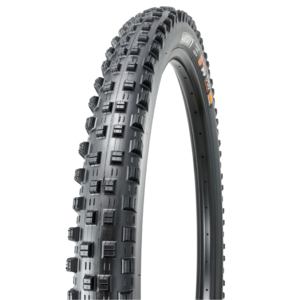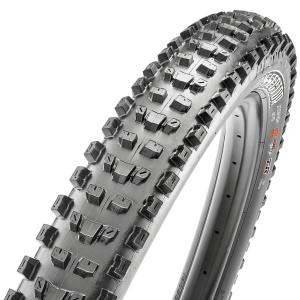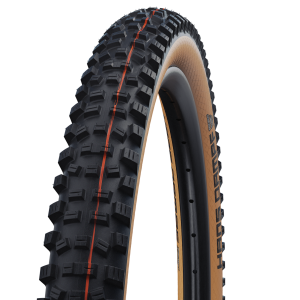Onza Aquila Tire
| Where To Buy | |||
|---|---|---|---|
Free shipping on orders over $50 (continental U.S. only).
International shipping available. Some exclusions apply. |
|||
Free shipping on orders over $50 (continental U.S. only).
International shipping available. Some exclusions apply. |
|||

Aaron Gwin’s hotel-notepad-drawing-turned-tire is not revolutionary in its looks, function, or purpose, but why reinvent the wheel (tire)? The Aquila was hotly lauded by many as the next best piece of rubber to hit the dirt upon its inception, and it immediately delivered by winning the 2017 World Cup DH Elite Men's overall title under its creator. From the dry hard-pack terrain of Leogang to the loose and wild steeps of Andorra or the deluge of Mont-Sainte-Anne, Onza’s golden ticket tire proved to be versatile and reliable.
When we were given a set for long-term testing after a press camp in Vermont, we were quite interested to take the tread into uncharted territory, away from the roots, loam, and hard pack of the North East where its performance was outstanding.
Fast forward to now and it’s summer in Queenstown, New Zealand. It hasn’t rained in weeks, as was the trend for the duration of the test. The steeps of the area are as loose as possible, rough as ever, and the soil is a mix of fine dust, rocks, and pine needles/mulch – a polar opposite to the soil conditions during our initial tests in Vermont. Riding the slick and unpredictable terrain in the antipodean summer takes a whole other kind of riding style, and having to worry about tires is not a thought one needs floating around under the helmet. Thankfully, the Aquila took no thinking to ride, but provided plenty to think about after the fact.

Strengths | Weaknesses |
|
|
Onza Aquila Tire Highlights
- 27.5 (650b) x 2.4-inches
- Uses a self-damping polymer structure developed specifically for the gravity application
- Uninterrupted vertical channel and refined edge knobs for maximum bite
- Aggressive braking edges with shallow sipes for added traction and feel
- Center and side knob aligned for maximum cornering predictability and increased feel through mid-lean angles
- Fast center tread with slightly softer side knobs for increased grip
- DH versions: DHC casing and steel bead with RC2 45a or VISCO GRP 40 rubber (tested) // 1,325g (claimed)
- Trail version (Coming Spring 2018): FRC casing with dual compound RC2 55a/65a rubber // 940g (claimed)
- Dual-ply DHC casing features a butyl inlay and 40x40 TPI bead-to-bead construction
- Tubeless compatible
- MSRP: $85 - DHC RC2 45a // $80 - DHC VISCO GRP 40 // $TBD - FRC RC2
"I know what works, what doesn't work; what I like, what I don't like. There wasn't a tire on the market that had everything that I wanted all wrapped into one tire." - Aaron Gwin
On The Trail
As simple as a tire is in theory, there are a lot of metrics by which it's possible to measure a tire’s performance. To concisely break down how we got on with the top-performing tire of the 2017 DH World Cup, here are all the factors we added up to rate the DHC VISCO GRP 40 version.
We ran them tubeless between 25 and 30psi, and the sweet spot was around 27psi front and 28psi rear for our 205-pound (93.0kg) tester. They were mounted to Novatec's Diablo XL rims (30mm inner width) in Vermont and DT 471 rims (25mm inner width) in New Zealand. We prefer the performance on the narrower rim width as it allows the tire’s rounder profile to really shine.
We were surprised how long the tire would hold an edge before letting go, especially in insanely loose moon dust in the bike park and pine ash on the trails.
Overall Traction
This is the name of the game, and without it you’re not going to be winning. The short and blocky pattern of the Aquila provides predictable corner roll, and leaning the tire onto edge or initiating a corner feels natural. The round profile of the tire gives the rider a lot of leeway to angle the bike without giving up edge hold or traction in general. We were surprised how long the tire would hold an edge before letting go, especially in insanely loose moon dust in the bike park and pine ash on the trails. Diving into ruts became a moment of confidence, not uncertainty, and railing hard-pack berms just felt right. You can feel the edge knobs finding purchase, clawing their way through debris or gluing themselves to firm dirt.
In Vermont, charging roots and wet rocks wasn’t an issue for this same reason – one can feel the point of contact and the give/take of the tire against the terrain. During early testing on a fall-line Burke Mountain descent in the freshest soil possible, across big compressions and quick corners cambered every which way, the tire first cemented itself as top-notch and that reputation carried across the globe to the rowdiest riding around.

Braking
Always a contentious point when discussing likes/dislikes of tires, the Aquila should find favor among most. Its square edge knobs and broad and blocky center knobs create ample braking surface and big contact points when the anchors need to be tossed. Being that this is a race tire, it is more geared towards hard braking on fast terrain versus the steep skid-track lock-up.
Pushing hard is encouraged, and when it all starts to come undone it does so in a way that doesn’t create a sudden departure from the track or the bike – just hang on, drop a foot, and look ahead… it all should come around.
On a whole, it slowed down similarly to a Maxxis Minion DHR II. It doesn’t have the “anchor” feeling of the Schwalbe Magic Mary or Maxxis Shorty, but it’s obviously more aggressive than the Schwalbe Hans Dampf or Maxxis Aggressor. It is a rather low-profile tire, so when it comes to slowing down in really loose, sandy dirt or loam, one can expect to be in control, but heavier riders might find a bigger profile tire is preferred. The center knobs are more like a Maxxis DHR II versus a Schwalbe Magic Mary, so that locked-in feel on very steep and slow chutes isn’t quite as aggressive.
Under hard braking the tire’s stiff casing keeps everything from squirming around and the spacing on the knobs maintains control while still cutting speed. It’s all very predictable regardless of how fast one is riding and the rider knows how it is all playing out, for better or worse (sometimes you’re a passenger despite your best efforts!).
Dry Grip
It’s all there. In the dry, this hoop of rubber inspires. The “slide point” is way out there. Pushing hard is encouraged, and when it all starts to come undone it does so in a way that doesn’t create a sudden departure from the track or the bike – just hang on, drop a foot, and look ahead… it all should come around.

Wet Grip
Watch Gwin's Mont Sainte Anne race run and you can decide for yourself if it performs in the wet, inside lines and all. We didn’t get a chance to hurl the tire through the mud, as those conditions never occurred, though we did find some wet roots and rocks upon which the tire performed without issue. The siping of all the knobs is likely a strong contributing factor to the versatile grip.
Ability to Self-Clean
While it may not be a house cat, we never had the tire clog up, even on the freshest of trails. Like any non-mud tire, however, there will certainly be a point at which the tread will pack up. If you want a mud tire, Onza makes the Greina for the sloppiest of times. We never faced this issue, however, even after stream crossings straight into loose dirt. Perhaps it’s better to say that the tire sheds like a house cat?


Cornering Grip
Trust the tire, it’s got you. When hitting bike park berms and jumps there is no doubt in the equation, and one can literally feel the side knobs biting to find purchase like magnets to a fridge. When the going gets less firm, the blocky nature of the tire digs into the chunder and turns it out like an auger. It feels like the tire is fighting for you when the going gets loose, and it feels good to have the Aquila in your corner when everything gets a bit too wild. The smart siping and spacing combines into a fierce force of friction, and the tire's blocky side knobs have huge support.
For people who ride a lot of bike park, hard pack, or rocky/root-infested trails, the Aquila will shine brightest.
Many refer to the Schwalbe Magic Mary as the current benchmark for holding a line, and the Maxxis Minion DHF is the classic tire for people who like cornering and forever copied because it’s a great all-rounder. The Aquila once again is more along the lines of the DHF, but perhaps a little more solid-feeling – stiffness is what the tire sports strongly over other options on the market. It doesn’t wiggle as much in loose berms as the DHF, but it doesn’t literally tear the earth in half like the Magic Mary.
For people who ride a lot of bike park, hard pack, or rocky/root-infested trails, the Aquila will shine brightest. If being a Loam Ranger is more of interest, a taller and more aggressive tread would be suggestible. With its roots firmly in racing though, it makes sense that the Aquila is dynamite on terrain which would commonly be found in race courses around the world, not Strava-hidden skid tracks that are “locals only” (which it is still perfectly comfortable on though).

Grip on Counterslopes
Similar to the cornering feel, off-camber moments are met with security and no afterthoughts. The tread carries the rider and the steed through the line chosen and out the other side. When initiating a turn on a counterslope, either into or against the camber, the round profile shines through by giving more area upon which to put rubber to dirt.
Gwin’s signature tire may be one of the secrets to his ability to hold speed like few others.
Rolling Resistance
A rolling stone gathers no moss, and this rolling tire gathers no dust. It’s a fast design which pedals like a trail tire while still performing its duties as a DH tire. Whether mounted to a big ol’ DH bike, an enduro race machine, or a fun trail weapon, the Aquila will hold onto speed like a dragon does gold. This is perhaps the real achievement Onza can claim with the Aquila, in that the tire rolls, and rolls, and rolls. Pedaling a DH casing tire is often like dragging around a wagon of bowling balls, but Gwin’s signature tire may be one of the secrets to his ability to hold speed like few others. It just wants to go, much like a Bontrager G4/G5. As an option for aggressive trail riding or enduro racing, it’d be a solid selection as energy is not pointlessly expended just trying to keep it rolling at pace.

Comfort
The damping characteristics of the Aquila is something Onza is very proud of with their chosen durometer and tire structure. There is absolutely a muted feeling to the rubber, which is a great thing because those little vibrations are knuckle-killers. Slamming the wheels into rocks, holes, roots, and braking bumps didn’t have a jarring sensation that one might expect from such a stiff tire. The compliance provided is just subtle enough to make one forget about this being a talking point in the first place.
Weight
We rode the DHC version, which weighs in at 1,325g – a pretty standard heft for a DH-worthy tire. With tires it will always be a game of support and durability vs rolling speed and un-sprung weight. We felt the weight of the tire didn’t negatively impact the ride quality of bike or handling characteristics. There are lighter tires and there are heavier – this tire is bought for its ability to deliver a predictable ride, not for how little it weighs. That said, Onza will soon bring a lighter 940g trail version to market with an FRC single-ply casing and reinforced sidewall.

Resistance to Pinching and Punctures
At the test camp in Vermont we rode with tubes in the tires. The tubes stayed safe, despite riding blind at “local’s pace” down some seriously rough trails (at 30psi).
In New Zealand we rode with a tubeless setup using Orange Seal and generic valves. After setting them up tubeless for the long-term test and leaving them for two weeks in the cave of bike maintenance, the tires lost just 10psi. During consistent use the tires have needed to be re-inflated exactly once, though pressures were verified fairly often.
We've experienced no sidewall or tread cuts. The casing on the Aquila is hearty and the bead is stiff, so steep chutes to slash-able corners and bike park g-outs didn’t manage to steal any of the sealant from our tires.
Long Term Durability
We've put 150 miles of riding on a pair of Aquila tires between Vermont (40 miles) and Queenstown (110 miles). About 80% of that mileage was trail riding, and 20% was road riding or gravel path while transferring between trails. In total, we did 19,078 feet of climbing and 34,339 feet of descending. From the photos below, it is plain to see that the tires could pass for new at a glance, and they held their ride quality from start to finish.




Quite impressively, there is very little cracking at the base of the knobs, the casing isn’t looking worn, and the braking edge on the rear tire has only just reached the point of consideration for replacement if you’re the kind of rider who doesn’t ride a tire until it's a semi-slick. We're impressed, particularly because a couple days of heavy bike park use didn’t roach the tire and mileage on the road and paths didn’t wear the rear down past the siping. Of the tires we’ve ridden, the longevity of the Aquila is approaching best-in-class. That said, the wear (or lack thereof) we experienced may be due to the lack of traction in the moon dust and sliding powder of Queenstown. We anticipate faster wear in rockier or firmer settings.
Of the tires we’ve ridden, the longevity of the Aquila is approaching best-in-class.
$80-$85 for a tire isn’t exactly cheap, but with some tires now going for more than a C-note Onza has priced the Aquila to be available to many. With the tires lasting so long, we think they're a sound investment. There aren’t many other grippy tires on the market that would hold up to over 150 miles of abuse and still look relatively fresh.

What's The Bottom Line?
Onza has a winning tire in the Aquila, professionally, but it's also something the average consumer would benefit from buying. The predictable ride quality, versatile design, and long wear life make it worth the price of admission. When a straightforward guy like Aaron Gwin is the designer, you know you’re going to get a product much like him: all-around ability with no frills or gimmicks, just a product of top quality and performance. If you race or just ride, this tire will see you through it all from the start gate to the trailhead. It's predictable at everything and an inspiring product. It may not make you ride like Aaron, but you’ll feel emboldened to at least give it your best try.
Visit www.onza-tires.com for more details.
About The Tester
Zach Faulkner - Age: 27 // Years Riding MTB: 17 // Height: 5'10" (1.78m) // Weight: 205-pounds (93.0kg)
Also known as #MTBJesus, Zach looks like a circus bear on a bicycle. His riding style has been compared to a landslide, replete with sounds of destruction and debris chasing his rear wheel down the hill. He rides flat pedals because they win medals, and he’s fond of quad-piston brakes on all of his bikes. His zeal for riding is life-long, having been astride a bike since before he was forming memories. Bikes kept him in the woods and out of trouble through his teenage years, and after more than a decade of racing DH, can now be found lying in the dirt next to race courses around the World behind a camera, writing at his computer late into the night, or out on the trail thundering through the woods.
Action photos by Jake Hood
Specifications
DH Tires: RC2 45A or VISCO GRP 40 rubber
Trail Tire: RC2 55A durometer on shoulder tread / 65A durometer on center tread
DH Tires: Downhill casing (DHC)
Trail Tire: Freeride / Bike Park (FRC) single ply casing
Aggressive braking edges with shallow sipes for added traction and feel
Center and side knob aligned for maximum cornering predictability and increased feel through mid-lean angles
| Where To Buy | |||
|---|---|---|---|
Free shipping on orders over $50 (continental U.S. only).
International shipping available. Some exclusions apply. |
|||
Free shipping on orders over $50 (continental U.S. only).
International shipping available. Some exclusions apply. |
|||






















27 comments
Post a reply to: Tested: Aaron Gwin's Signature Series Onza Aquila Tire